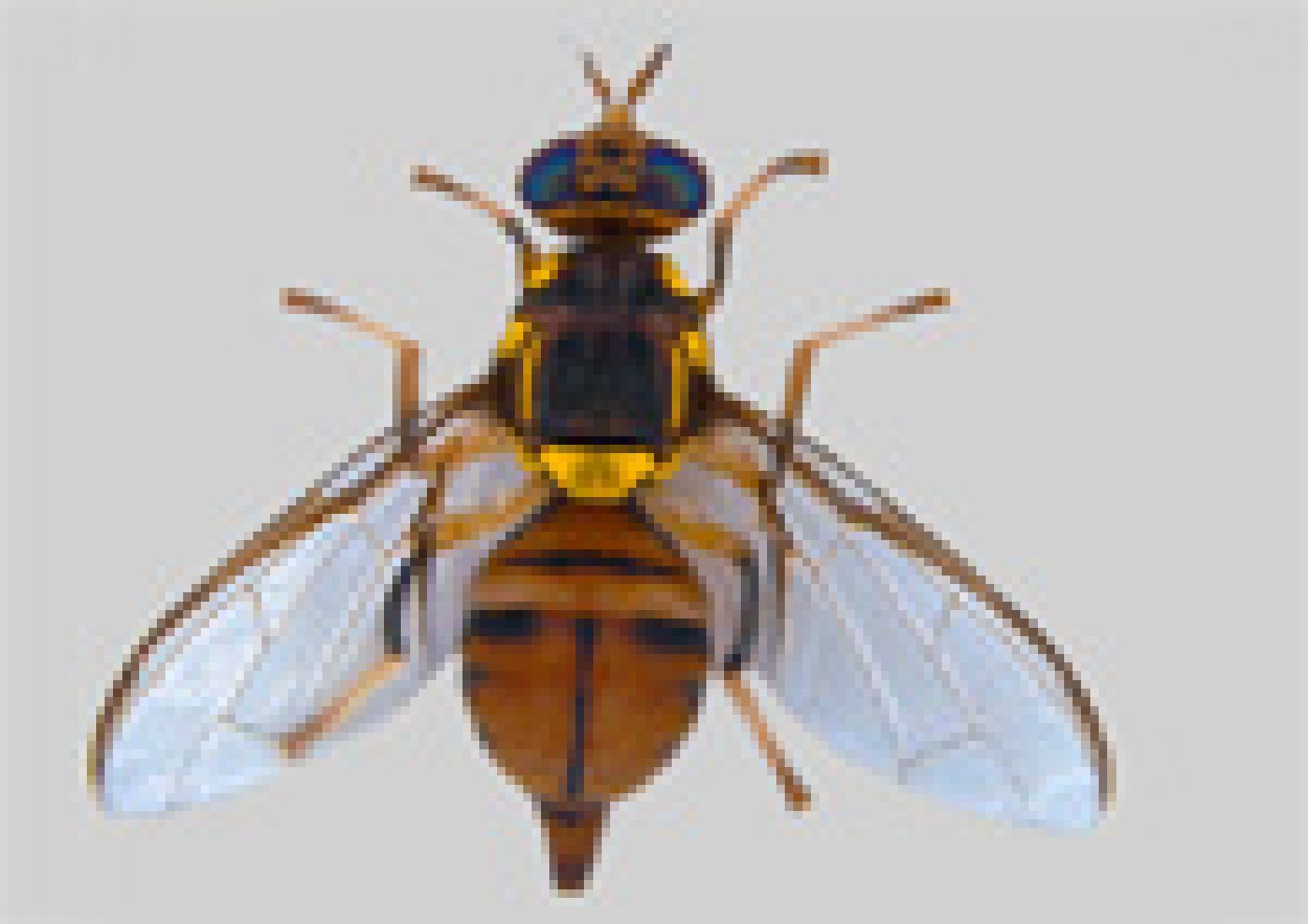
Symptoms: The pest is active throughout the year in South India, whereas in northern parts it hibernates during winter (November to March) in pupal stage. The flies breed on fruits that are mature and lay eggs below the fruit epidermis (1-4 mm deep). On hatching the maggots feed on pulp of these fruits. As a result a brown patch appears around the place of oviposition and the infested fruits start rotting. These affected frits drop down prematurely and the maggots come out of these fruits to pupate in the soil and population increases rapidly during summer.
Control: Pre harvest Management (45 days prior to harvest)
• Destroy all fallen fruits at weekly intervals
• Install methyl eugenol traps @ 8-10/ acre. Recharge the traps for every 20 days.
• Avoid delay in harvest
Post harvest Management (within 24 hr after harvest)
Follow the above pre-harvest treatments with a post-harvest hot water treatment, (within 24 hr after harvest after desapping and sorting) at 48°C (maintained by thermostat) for one hour.
Mango fruit fly trap
The trap works on a simple Male Annihilation Technique (MAT). The trap consists of a small plastic container with a piece of plywood treated with methyl eugenol and dichlorovos which in hung on the tree. This trap attracts the male fruit fly. In the absence of males, females fail to procreate and hence the fruit will be free from infestation. Six to eight traps are required for each acre.
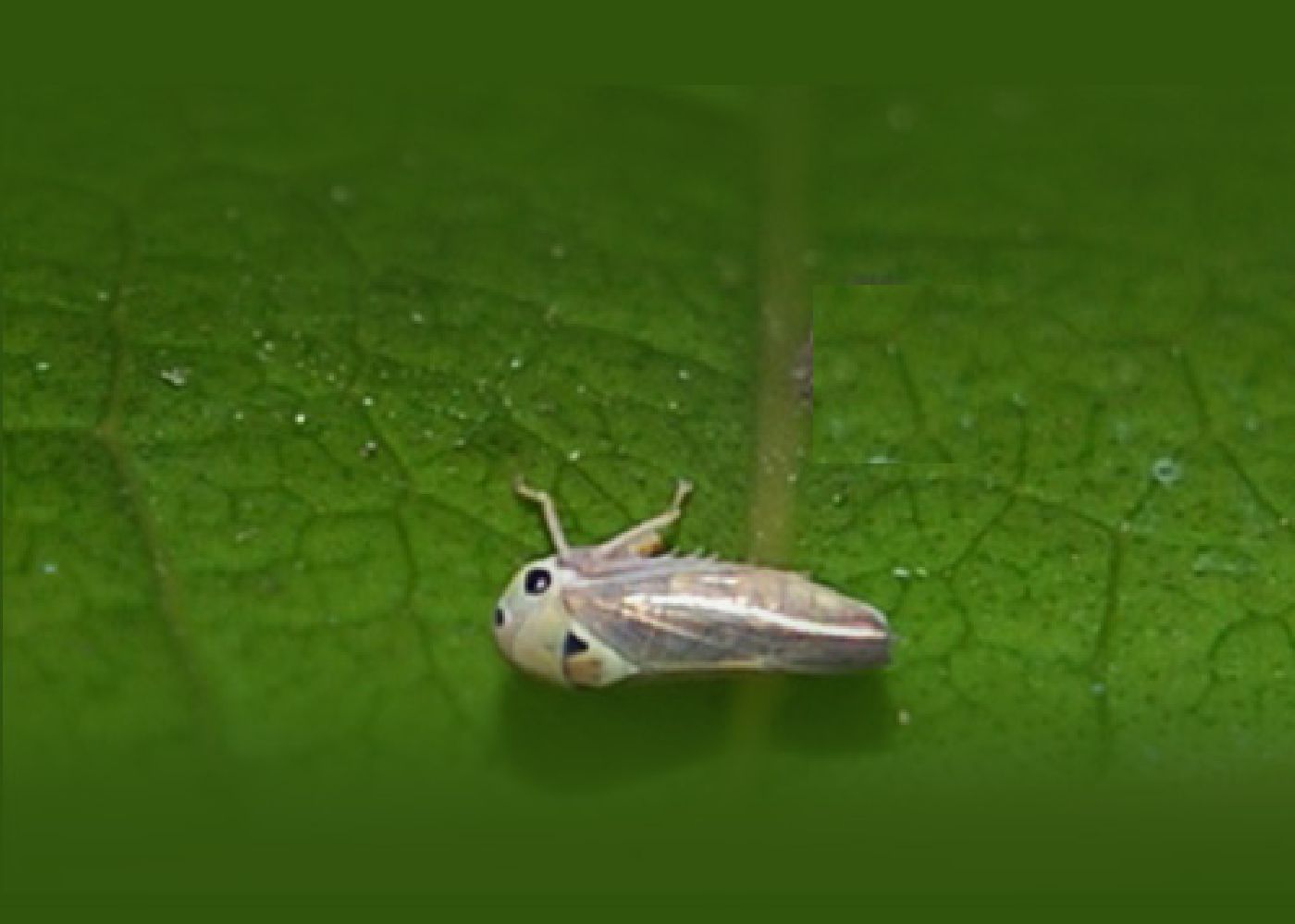
The critical crop stage for spraying is panicle emergence when hopper density exceeds four per panicle. Spraying of imidacloprid 200 SL @ 0.3 ml/L or lamdacyhalothrin @ 0.5ml/L, IIHR’s neemsoap@10gm/L, or Azadirectin 3000ppm @ 3ml/L are effective for control.
Symptoms: There are several species of hoppers damaging mango crop all over India. Enormous numbers of nymphs are found clustering on the inflorescence during spring, sucking the sap. The infested flowers shrivel, turn brown and ultimately fall off. On attaining maturity the hoppers leave the blossoms and move on the leave. Swarms of adults are commonly seen hovering in mango groves and sitting on all plant parts. The hoppers excrete honeydew that covers the inflorescence, leaves and fruits encouraging black sooty mold, which affects photosynthetic activity of leaves and market quality of fruits.
Control :
a) At high hopper density (>4 hoppers/ panicle)
A spray of Imidacloprid 0.005% or Lambda cyhalothrin 0.0025% at early panicle emergence and a spray at pea-size of fruit stage will reduce the hopper density.
b) At low hopper density (< 4 hoppers/ panicle)
If population is low to moderate, azadirachtin 0.3% @ 2 ml/litre can limit hopper build up. One should be wary of hoppers even after fruit development as a sudden influx can affect fruit quality. Subsequent spray should be only with Carbaryl 0.2%.
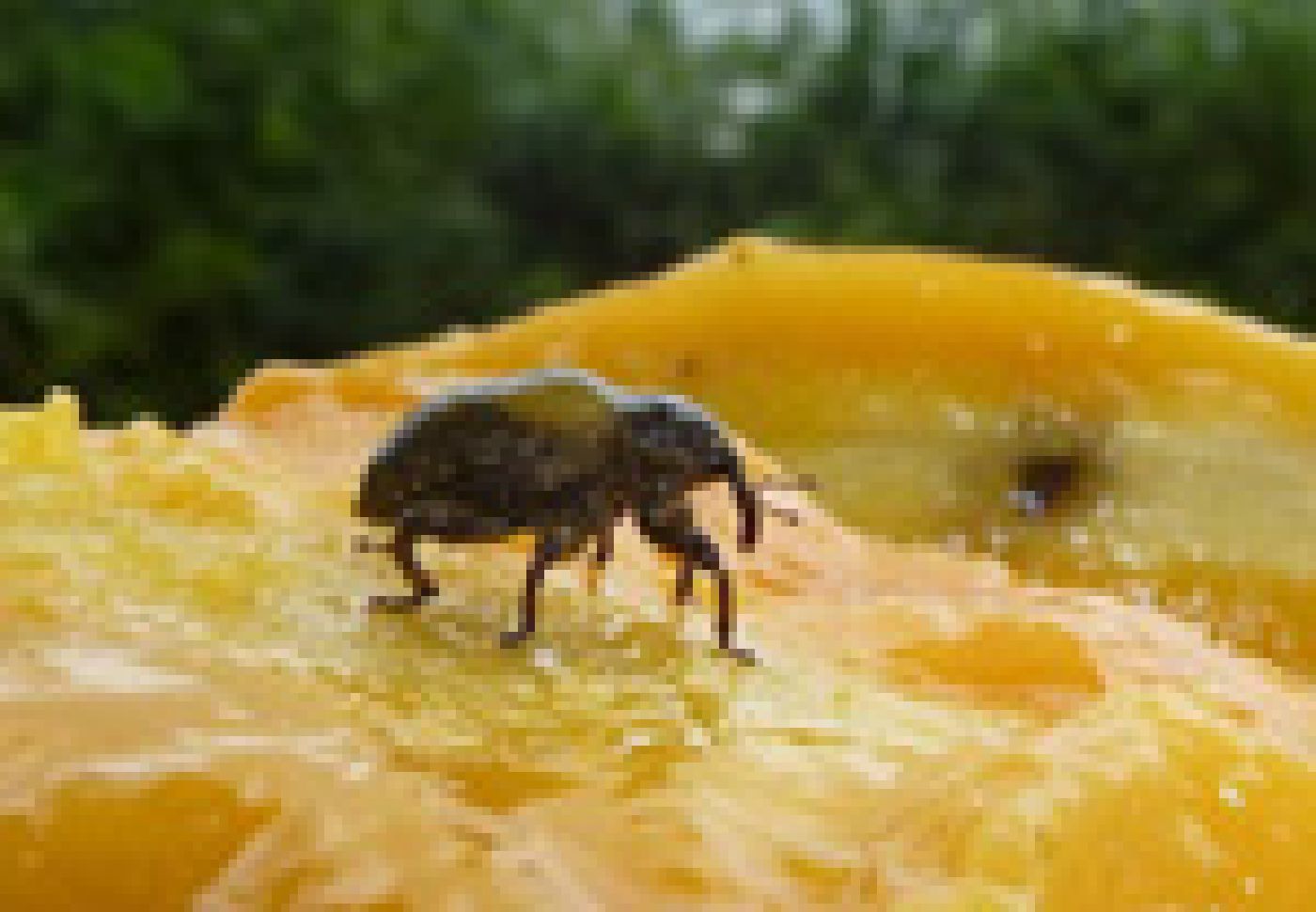
Spraying deltamethrin (0.0028%) on tree trunk during off-season and on fruits at lime size is recommended. Removal and destroying of all fallen fruits and seeds after harvest helps to reduce the pest population in the subsequent season.
Symptoms: It is a specific pest of mango. Eggs are laid singly on the epicarp of partially developed fruits. The grubs emerged bore through the pulp, feed on seed coat and later damage the cotyledons. Pupation takes place inside the seed along the concave side. During the process of adult emergence, the adult drags the faecal matter in the seed in to the pulp leading to spoilage of pulp. There is only one generation in a year. Adult weevils are inactive from July- August till next fruiting season.
Control:
• Spray main trunk, primary branches and junction of branches during off season (Aug- Sept) with chlorpyrifos 0.05% to kill hiding weevils.
• Spray acephate 0.1125% at lime size followed by decamethrin 0.0028% after two to three weeks.
• After harvest destroy all leftover seeds in the orchard or in the processing industries.
• If seeds are sown for rootstock, then drench pots with chlorpyrifos 0.05%.
(The last two will help managing stone weevils for the following year).
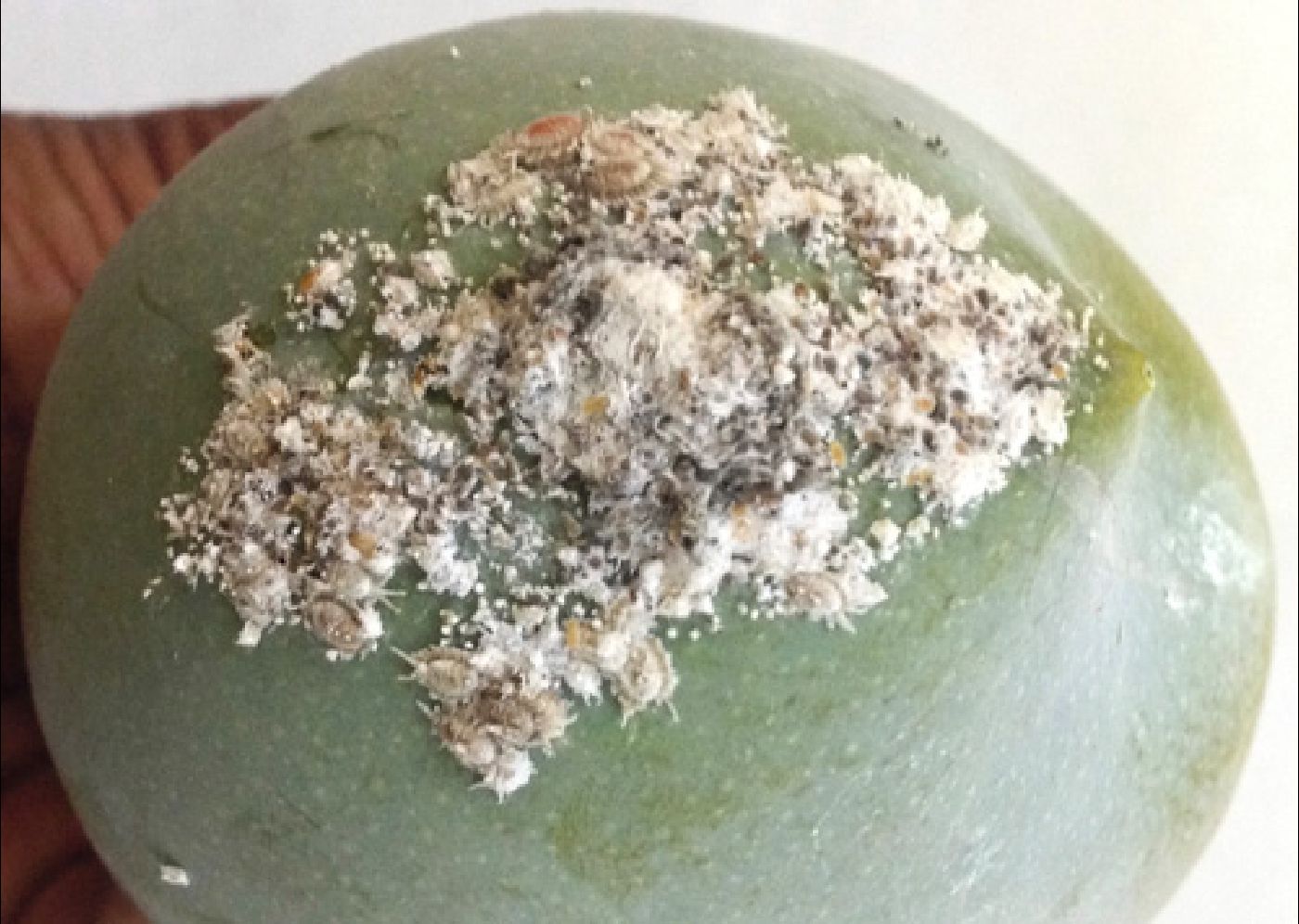
It is one of the serious pests of mango. Ploughing the soil during summer, applying 25 cm alkathene bands on the trunks and spraying garlic oil (1%) or neem extract (4%) below the bands help in controlling this pest. Spraying and drenching with Chlorpyriphos (0.05%) also helps in control.
Symptoms: The mango mealybug, Drosicha mangiferae is responsible for devastating the mango crop mainly in north India. It is easy to recognize the mealybug by its large flattish and plump females, which are covered with a white mealy covering. However, in south India the other species viz., Rastrococcus iceriyodes, Ferrisia virgata, etc are becoming serious on mango. The irregular flushing due to change in the mango phenology mediated through climate have accentuated the incidence of these pests.
Control:
1. Prune and destroy the affected plant parts
2. Remove weeds and grasses by ploughing the adjacent areas
3. Sprays of neem oil @ 0.5% during off-season restricts the spread
4. Band trees with 20 cm alkathene or polythene (400 gauge) sheets, 50 cm above the ground level and just below the junction of the branching (mainly for Drosicha) with suitable glue to trap ascending crawlers.
5. Release Cryptolaemus montrouzieri grubs @ 2/ infested shoot.

Shoot borer
This pest destroys young plant if neglected. Spraying of acephate @ 1.5g/L or Quinalphos (0.05%) or Dimethoate (0.045%)is recommended.
Symptoms: This borer has become quite destructive and more common on young tender shoots. The caterpillars bore into midribs of tender leaves and tunnels downwards near the growing point throwing excreta. The affected growing point dies with characteristic tip wilting and drying. Usually, the affected tip puts forth several shoots. Seldom, this borer attacks inflorescence.
Control:
1. The attacked shoots may be clipped off and destroyed.
2. Spraying of quinalphos @ 2.5 mL/L at fortnightly intervals (2-3 sprays depending on intensity of infestation) from the commencement of new leaves gives effective control.
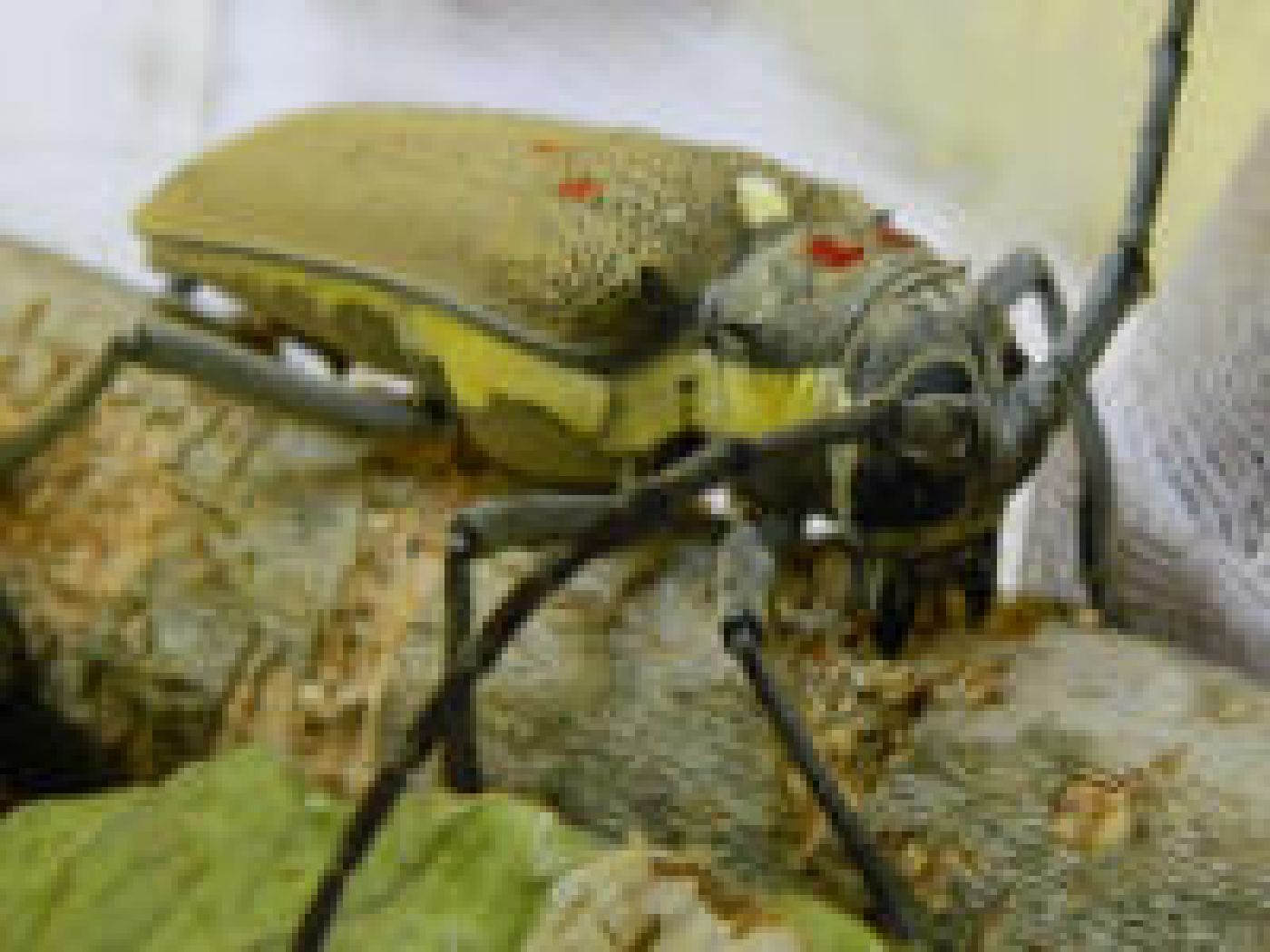
Stem borer
This is becoming a serious pest, especially of old orchards. Infestation leads to die back and death of tree. Orchards should be maintained healthy and active larval holes should be identified based on the appearance of fecal matter and chewed tissues protruding out, which should be plugged with cotton dipped in dichlorovos (0.05%) or petrol and covered with mud. Grubs can also be collected manually by inserting a metal hook and killed.
Symptoms: The stem borer is increasingly becoming a menace in the older (>10 years) mango orchards across the country.
The grubs bore and feed below the bark on vascular tissues thereby interrupting nutrient and water transport. As it grows, the tunneling is extensive below the bark, mostly invisible from outside. Frass comes out from infested holes and sometimes sap oozes out. The damage results in yellowing of branches followed by drying and die back of terminal shoots/ branches ultimately leading to the death of whole tree.
Control:
1. An early diagnosis and management can help in saving the tree from dying.
2. A formulation ‘Sealer cum healer’ developed by IIHR to tackle the menace. This formulation when applied following bark cleaning, swabbing (of dichlorvos @ 5 mL/L + COC @ 40 g/ L per kg of sealer cum healer) not only controls from borer damage but also protects the tree from the secondary infection and helps in rejuvenation of tree.